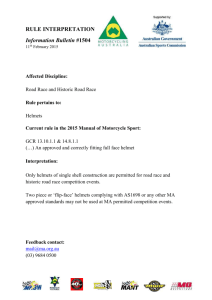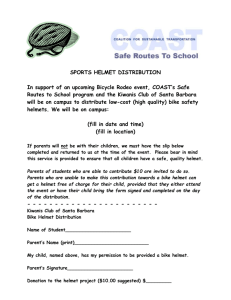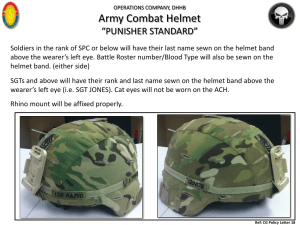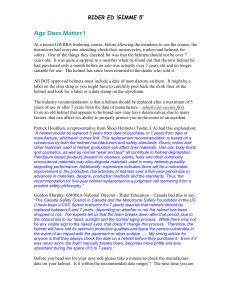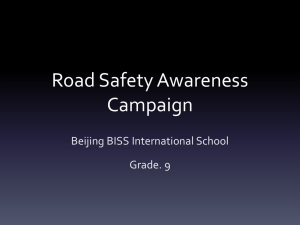September 2006: Helmet Safety
advertisement
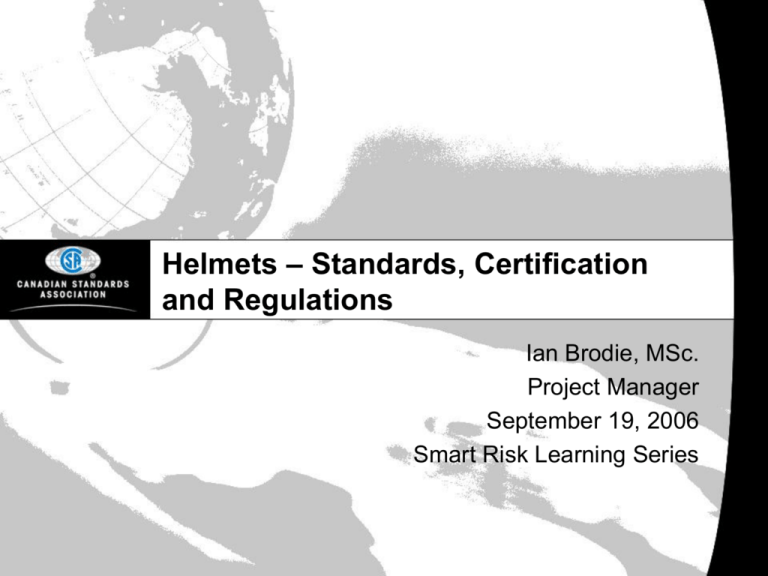
Helmets – Standards, Certification and Regulations Ian Brodie, MSc. Project Manager September 19, 2006 Smart Risk Learning Series Agenda • Helmets Types of Helmets How helmet absorbs an impact • Standards What is a standard? Standards system in Canada Who develops standards • Helmet Standards Common requirements Comparison of bicycle helmet standards • Certification Types of certification • Helmet Regulations in Canada 2 Helmets • Two types of helmets Single impact Multi-impact • Components of a helmet Outer shell Liner Retention system Comfort padding/adjustment system 3 Types of Helmets 4 Components of a Helmet • Outer shell • Increases the area over which the force is dissipated Aids in letting the helmet side along the surface during an impact Holds the liner together during an impact Helps prevent the penetration of sharp objects Liner Absorbs the force of an impact by deforming • Retention system keeps the helmet on your head • Comfort padding/adjustment system Assists in fitting the helmet properly 5 Overview of Standards • Standards in general information documents stipulate requirements for the safety, performance and operation of products, processes, services and systems outline industry guidelines and good practices represent minimum requirements are voluntary; compliance becomes mandatory only when the standards are referenced in legislation or regulation 6 Types of Standards • • • • Organization Standards (e.g. CSA) National Standards of Canada Bi/Tri-nation Standards International Standards (ISO, IEC) 7 What can Standards Do? • Standards serve a variety of market perfecting purposes product uniformity establish consistent technologies promote compatibility of products ensure desired quality and performance levels 8 National Standards System • Independent organizations accredited by the Standards Council of Canada • Standards Development, Certification, Testing, and Registration • Members must be impartial and technically competent • SCC operates accreditation programs 9 Standards Development Organizations National Standards System Standards Council of Canada SCC BNQ UL CSA CGSB 10 Helmet Standards • Impact testing Helmet is placed on a headform, equipped with an accelerometer and dropped from a defined height The helmet will be impacted at various locations (e.g., crown, front, side, rear) The accelerometer will measure how well the helmet attenuates the impact The standard will define the pass/fail criteria for the acceleration reading (e.g., 275 g, were 1 g =9.8 m/s2) Helmets are tested at different temperatures 11 Helmet Standards – drop rig Key 1 base 2 anvil 3 velocity sensor 4 headform 5 follower mechanism 6 monorail 12 Helmet standards – drop rig 13 Helmet Standard – area of coverage • Specifies the area that a helmet must cover on a headform • Area of coverage differs between Standards for the same type of helmet (e.g., cycling) Different types of helmets (e.g., hockey vs. cycling) 14 Helmet Standards – area of coverage Hockey Helmet Cycling Helmet 15 Helmet Standards – retention system • A force is applied to the retention system to assess If the fastener releases The elongation of the retention system 16 Helmet Standards - retention system Test Apparatus 17 Helmet Standards – Other Tests • Stability test Assesses the ability of the helmet to stay on the headform Used in the CSA cycling helmet standard • Penetration test Object of defined sized is inserted into opening in the shell to see if contact can be made with the headform Used in the CSA hockey helmet standard 18 Certification • Two types of certification Third party certification is undertaken by an organization that is independent of the manufacturer seeking certification. Self certification the manufacturer or producer himself takes responsibility for certifying conformity of the product. 19 Certification – Third Party • An accredited third party test lab verifies product meets the standard • There are annual reviews/inspection of production product to confirm product is still meeting the standard • The lab issues the manufacturer certification labels to affix to the product • There are costs to the manufacturer to receive third party certification 20 Certification - labels 21 Certification – Self Certification • The manufacturer is giving assurance that the product conforms to a specific standard • For industry, self certification means Decreased costs Avoids the duplication of testing when the product is being sold in different countries Reduces the regulatory burden 22 Certification - Helmets • Third party certification CSA SNELL • Self certification ASTM CPSC DOT • For the most part, helmets available for sale are self certified by the manufacturer 23 Which Helmet for Which Activity Source: City of Ottawa 24 Multi-purpose helmets • There are Manufacturers making claims that their helmets meet multiple standards (e.g. CPSC bicycle helmet standard and the ASTM F1492 Skateboard helmet standard) Standards where the scope states the intended use is for more than one type of recreational activity (e.g., SNELL standard for Non-motorized vehicles, CEN 1078, Helmets for pedal cyclists and for users of skateboards and roller skates ) 25 Regulations and Market Realities in Canada • Regulations Hazardous Products Act (Health Canada) as it relates to consumer products, consists of two parts. Items included in Part I of Schedule I are banned from import, sale, or advertisement in Canada. Products included in Part II of Schedule I must meet specific regulations in order to be imported, sold or advertised in Canada. Provincial Traffic Acts provinces reference standards that a motorcycle or cycling helmet must meet • Sport Governing Bodies 26 Regulations and Market Realities in Canada • Market realities Large percentage of helmet manufacturers are outside of Canada For the most part, helmets are not required to meet any standards Exceptions Hockey helmets (reference in Hazardous Products Act) Cycling helmets (where there is provincial legislation) Motorcycle helmets The industry’s preference is to self-certify their helmets The dominant standards being used are Hockey - CSA Cycling – CPSC Motorcycling – Department of Transportation (DOT) 27 Questions and Comments 28
